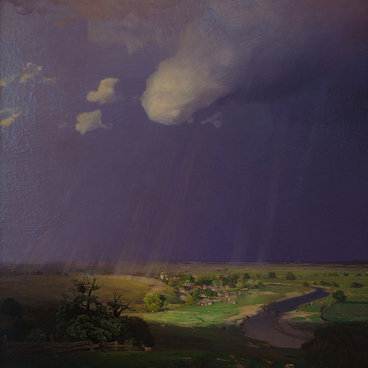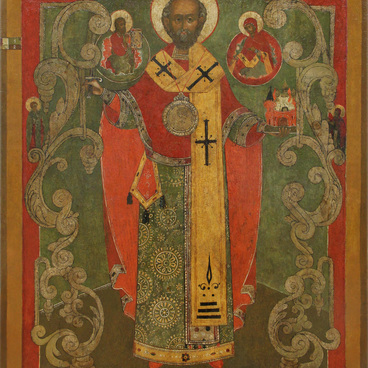The icon Crucifixion with Scenes from the Passion of Christ was painted by an unknown artist. It provides a detailed account of canonical scenes and characters from the New Testament. What makes this icon particularly interesting is the degree of detail and a wide range of scenes that it offers.
The central part of the icon depicts the crucifixion of Christ in line with the traditional iconography: Christ nailed to the Cross at Golgotha, a cave with the tomb of Adam, the first man. Flanking the cross there are two groups of Bystanders: Our Lady and Mary Magdalene standing slightly behind her on the left; Apostle St. John the Evangelist and Longinus the Centurion on the right.
The upper part of the icon above the Bystanders’ figures presents the Passion scenes, whose iconography evolved much later, although some of these scenes were known already in the early-Christian time. In Russian icon-painting the earliest and most popular were the scenes of the Feasts tier of the Assumption Cathedral in Vladimir.
The central part of the icon called radiance features the Lord of Sabaoth making the blessing gesture with His right hand and holding the sceptre in His left hand. Sabaoth is one the God’s titles in the Judeo-Christian tradition that translates literally as the Lord of Hosts. Above Christ’s head is a haloed dove that symbolizes the Holy Spirit.
In icon painting, the Passion of Christ is based on the final parts of the Gospel that tell about the last days of the earthly life of Jesus, his sacrificial death and suffering, the so-called Passion, on the Cross: from the Last Supper with his disciples to the Entombment and Resurrection. The first known example of the Passion scenes in Russian icon painting were icons in the Feasts tier of the Assumption Cathedral in Vladimir, while the most ancient ones that have survived are in the Assumption Cathedral of the Kirillo-Belozersky Monastery.
The upper part of the icon includes 12 marginal scenes of the Passion depicted against a silver background: the Last Supper, the Washing of the Feet, the Agony in the Garden, the Kiss of Judas, Christ before Pontius Pilate, Christ before Annas and Caiaphas, the Judgement of Pontius Pilate, the Mocking of Christ, Christ Carrying the Cross, the Descent from the Cross, the Entombment and the Resurrection. The Crucifixion icon is placed in the Feasts tier of the iconostasis.
The central part of the icon depicts the crucifixion of Christ in line with the traditional iconography: Christ nailed to the Cross at Golgotha, a cave with the tomb of Adam, the first man. Flanking the cross there are two groups of Bystanders: Our Lady and Mary Magdalene standing slightly behind her on the left; Apostle St. John the Evangelist and Longinus the Centurion on the right.
The upper part of the icon above the Bystanders’ figures presents the Passion scenes, whose iconography evolved much later, although some of these scenes were known already in the early-Christian time. In Russian icon-painting the earliest and most popular were the scenes of the Feasts tier of the Assumption Cathedral in Vladimir.
The central part of the icon called radiance features the Lord of Sabaoth making the blessing gesture with His right hand and holding the sceptre in His left hand. Sabaoth is one the God’s titles in the Judeo-Christian tradition that translates literally as the Lord of Hosts. Above Christ’s head is a haloed dove that symbolizes the Holy Spirit.
In icon painting, the Passion of Christ is based on the final parts of the Gospel that tell about the last days of the earthly life of Jesus, his sacrificial death and suffering, the so-called Passion, on the Cross: from the Last Supper with his disciples to the Entombment and Resurrection. The first known example of the Passion scenes in Russian icon painting were icons in the Feasts tier of the Assumption Cathedral in Vladimir, while the most ancient ones that have survived are in the Assumption Cathedral of the Kirillo-Belozersky Monastery.
The upper part of the icon includes 12 marginal scenes of the Passion depicted against a silver background: the Last Supper, the Washing of the Feet, the Agony in the Garden, the Kiss of Judas, Christ before Pontius Pilate, Christ before Annas and Caiaphas, the Judgement of Pontius Pilate, the Mocking of Christ, Christ Carrying the Cross, the Descent from the Cross, the Entombment and the Resurrection. The Crucifixion icon is placed in the Feasts tier of the iconostasis.

